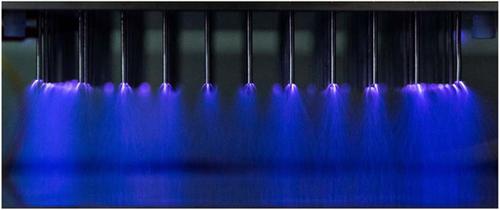当前位置:
X-MOL 学术
›
Plasma Processes Polym.
›
论文详情
Our official English website, www.x-mol.net, welcomes your
feedback! (Note: you will need to create a separate account there.)
Diagnostics of a large volume pin-to-plate atmospheric plasma source for the study of plasma species interactions with cancer cell cultures
Plasma Processes and Polymers ( IF 2.9 ) Pub Date : 2021-02-24 , DOI: 10.1002/ppap.202000250 Laurence Scally 1, 2 , Sean Behan 1 , Andressa M. Aguiar de Carvalho 1, 3, 4 , Chaitanya Sarangapani 1 , Brijesh Tiwari 3 , Renee Malone 1 , Hugh J. Byrne 5 , James Curtin 1 , Patrick J. Cullen 2, 6
Plasma Processes and Polymers ( IF 2.9 ) Pub Date : 2021-02-24 , DOI: 10.1002/ppap.202000250 Laurence Scally 1, 2 , Sean Behan 1 , Andressa M. Aguiar de Carvalho 1, 3, 4 , Chaitanya Sarangapani 1 , Brijesh Tiwari 3 , Renee Malone 1 , Hugh J. Byrne 5 , James Curtin 1 , Patrick J. Cullen 2, 6
Affiliation

|
A large gap pin-to-plate, atmospheric-pressure plasma reactor is demonstrated as means of in vitro study of plasma species interactions with cell cultures. By employing optical emission and optical absorption spectroscopy, we report that the pin-to-pate plasma array had an optimal discharge frequency for cell death of 1000 Hz in ambient air for the target cancer cell line, human glioblastoma multiform (U-251MG). The detected plasma chemistry contained reactive oxygen and nitrogen species including OH, N2, N2+ and O3. We show that by varying the plasma discharge frequency, the plasma chemistry can be tailored to contain up to 8.85 times higher levels of reactive oxygen species (ROS) as well as a factor increase of up to 2.86 for levels of reactive nitrogen species (RNS). At higher frequencies, ROS are more dominant than RNS, which allows for a more dynamic and controlled environment for sample study without modifying the inducer gas conditions. When used for treatment of culture media and cell cultures, variation of the plasma discharge frequency over the range 1000–2500 Hz demonstrated a clear dependence of the responses, with the highest cytotoxic responses observed for 1000 Hz. We propose that the reactor offers a means of studying plasma–cell interactions and possible cofactors such as pro-drugs and nanoparticles for a large volume of samples and conditions due to the use of well plates.
中文翻译:

用于研究血浆物种与癌细胞培养物相互作用的大容量针板大气等离子体源的诊断
大间隙针板、大气压等离子体反应器被证明是体外研究血浆物种与细胞培养物相互作用的手段。通过使用光发射和光吸收光谱,我们报告说,对于目标癌细胞系人多形胶质母细胞瘤 (U-251MG),针到顶等离子体阵列在环境空气中具有 1000 Hz 的最佳细胞死亡放电频率。检测到的等离子体化学物质包含活性氧和氮物质,包括 OH、N 2、N 2 + 和 O 3. 我们表明,通过改变等离子体放电频率,等离子体化学可以定制为包含高达 8.85 倍的活性氧 (ROS) 水平以及活性氮 (RNS) 水平的因子增加高达 2.86 . 在更高的频率下,ROS 比 RNS 更占优势,这允许在不改变诱导气体条件的情况下为样品研究提供更加动态和受控的环境。当用于处理培养基和细胞培养物时,等离子体放电频率在 1000-2500 Hz 范围内的变化表明响应具有明显的依赖性,在 1000 Hz 时观察到最高的细胞毒性响应。
更新日期:2021-02-24
中文翻译:

用于研究血浆物种与癌细胞培养物相互作用的大容量针板大气等离子体源的诊断
大间隙针板、大气压等离子体反应器被证明是体外研究血浆物种与细胞培养物相互作用的手段。通过使用光发射和光吸收光谱,我们报告说,对于目标癌细胞系人多形胶质母细胞瘤 (U-251MG),针到顶等离子体阵列在环境空气中具有 1000 Hz 的最佳细胞死亡放电频率。检测到的等离子体化学物质包含活性氧和氮物质,包括 OH、N 2、N 2 + 和 O 3. 我们表明,通过改变等离子体放电频率,等离子体化学可以定制为包含高达 8.85 倍的活性氧 (ROS) 水平以及活性氮 (RNS) 水平的因子增加高达 2.86 . 在更高的频率下,ROS 比 RNS 更占优势,这允许在不改变诱导气体条件的情况下为样品研究提供更加动态和受控的环境。当用于处理培养基和细胞培养物时,等离子体放电频率在 1000-2500 Hz 范围内的变化表明响应具有明显的依赖性,在 1000 Hz 时观察到最高的细胞毒性响应。











































 京公网安备 11010802027423号
京公网安备 11010802027423号